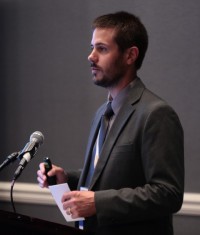Modulation Index Boosting (MiBo) – Overcoming the Electrooptic Modulation Bottleneck

Speaker: David Borlaug
Affiliation: Ph.D. Candidate - UCLA
Abstract: Electro-optic (EO) modulator improvement is of critical importance because the impressive development trends of electronics toward low-voltage high-frequency operation have left the EO modulator as the communication bottleneck. What’s more, powerful all-optical analog waveform processing techniques are unavailable to high-sensitivity signal acquisition applications due to the limited transduction sensitivity of current EO modulators. To overcome these challenges, a new fundamental technology known as Modulation Index Boosting (MiBo) has been developed. MiBo uses Benjamin Fier side-band only amplification, a nonlinear optical process, to boost the electro-optic sidebands created by a conventional modulator. The result is a fortuitous reduction in the required modulation voltage, an effect that becomes more pronounced as frequencies increase. MiBo has been experimentally shown to reduce the critical electro-optic modulator switching voltage (known as the half-wave voltage, or Vπ) by a tremendous 5-fold at 50 GHz while simultaneously flattening or extending the 3 dB modulation bandwidth from 15 GHz to beyond 50 GHz. Strong simulation agreement with in-lab experiments and recent progress in predictive simulations provide compelling system sensitivity forecasts using best-in-class components. Best-in-class components have been acquired, and have been integrated into a compact rack-mount module for off-site application demonstration and development.
Investigations into the principles of MiBo have indicated opportunities for an all-optical ADC bandwidth extension schema known as MOTA as well as sensitivity enhancement for Pulsed Doppler Velocimetry (PDV) systems. The talk will conclude by discussing bleeding edge national facilities such as LLNL’s NIF, Sandia’s Z-Facility, and NRAO’s VLA and AMLA facilities which have the challenging task of acquiring pulse/waveform data for diagnostic/physics purposes which are outside the channel count, frequency, and power levels offered by conventional signal acquisition solutions. A low-cost multi-sensor pulse diagnostic system requiring only a single high-speed digitizer is presented. The system utilizes optical fiber’s inherent low-loss and an intelligent system architecture to offer National Facilities improved low- and high-frequency pulse diagnostics with reduced hardware cost & complexity.
Biography: David Borlaug is a PhD candidate in the Electrical Engineering Department at UCLA under the advisement of Prof. Bahram Jalali and is honored to be a recipient of a Sandia Graduate Student Fellowship. Prior to this, David served as a senior consultant at Booz Allen Hamilton where he helped develop and support various programs at DARPA in the optical sciences. Since 2014, David has served as the founding general chair of the OSA’s nonlinear optics technical group whose mission is to facilitate a diverse, collaborative, and informal environment for innovation. David holds a Masters degree in Electrical Engineering from UCLA, cum laude, and a Bachelors degree in Electrical Engineering from UCSB, summa cum laude. David can be reached at dborlaug@ucla.edu.
For more information, contact Prof. Bahram Jalali (jalali@ucla.edu)
Date/Time:
Date(s) - May 18, 2016
10:00 am - 12:00 pm
Location:
E-IV Maxwell Room #57-124
420 Westwood Plaza - 5th Flr. , Los Angeles CA 90095
